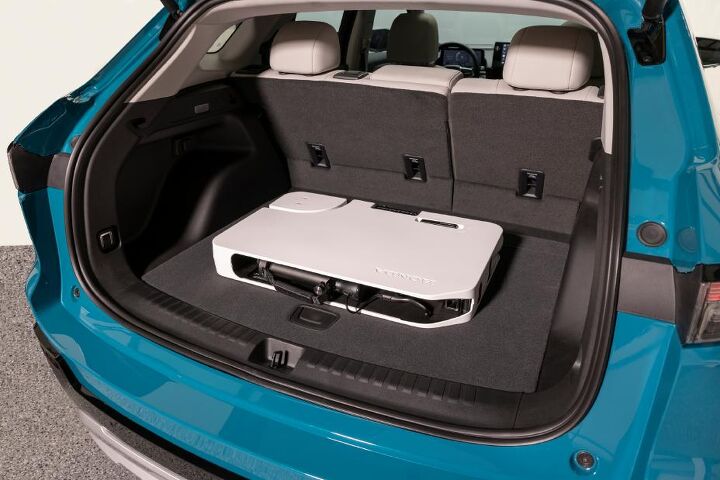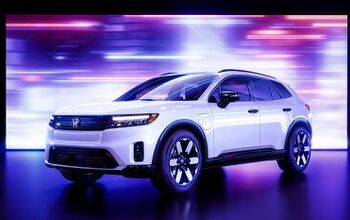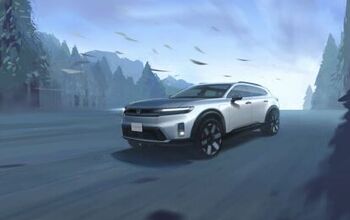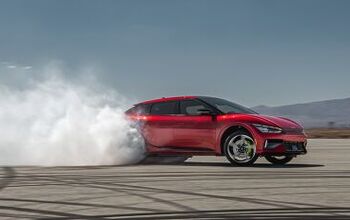Honda Previews the 2024 Prologue

Honda has formally unveiled the all-electric Prologue, indicating that the brand hasn’t given up on electrification. The midsize crossover boasts an agreeable estimated range of (up to) 300 miles and is designed to cater to more mainstream tastes.
As a preeminent manufacturer of modestly sized combustion engines, it makes sense that the company would want to stick to what it knows best. Like several other Japanese brands, Honda has been hesitant to embrace electric vehicles with the same zeal as its European or American rivals. However, external pressures are beginning to force the issue, and this seemed an agreeable solution for the company.
By relying on General Motors’ Ultium battery platform, Honda gets to field an EV boasting a competitive range while bragging to regulators about products being manufactured in North America. Though the vehicle itself will be assembled in Mexico, those Ultium units are technically a collaboration between GM and South Korea’s LG Energy Solution.
That’s “American Made” in the vaguest of senses. But it should be good enough to warrant government incentives under the EV tax credit scheme.
Still, it’s the vehicle itself that will determine success on the market and Honda seems to have something worthy of consideration on paper.
The 2024 Prologue comes with either a single-motor front-wheel-drive configuration or a dual-motor all-wheel-drive setup — the latter of which is supposed to yield a factory estimated 288 horsepower and 333 pound-feet of torque.
Power figures for the front-wheel drive version have not been revealed yet. However, it will undoubtedly be less powerful and weigh less. As Honda clearly wants to lead with the biggest numbers, it has said the single-motor model with a 85.0-kWh battery pack should offer a maximum range somewhere around 300 miles. Anticipate a little less on the dual-motor variant with everything else being even.
We can also do a little guess work with the help of the forthcoming Chevrolet Equinox EV the Prologue shares its platform with. GM is pegging the electric Equinox at 210 horses and 243 pound-feet of torque, numbers that may be mimicked by Honda’s front-drive EV.
Considering that the vehicle will assuredly weigh over 4,000 pounds, that’s not likely to make the base model all that thrilling. Though it’ll be enough to get where you need to be and the spicier all-wheel drive model should be able to offer some thrills below 60 mph. We could certainly be wrong. But the specs we’ve seen and the general theme of this car seem to indicate it's trying to emphasize practicality.
This is also represented by the Honda’s shape. At 192 inches long, the Prologue is larger than both the CR-V and the larger Passport. Its status as an EV also means some interior space can be freed up. It’s also quite wide at 78.3 inches with a wheelbase of 121.8 inches.
Honda said the EX trim should offer 25.2 cubic feet of cargo space behind the rear seats and 57.7 cubic feet with them folded. That’s not as good as we were expecting from the brand. The smaller CR-V boasts more room for cargo in both cases while the larger Passport absolutely demolishes the Prologue in terms of maximum cargo capacity.
If you’re wondering where the space went, the Prologue has a relatively low roof height (it kind of resembles a boxy station wagon at just 64.7 tall) and seems to have relegated a fair bit of room for added comfort. It also has no forward storage (or frunk) due to how the front-mounted motor has been engineered. However, legroom is supposed to be more than ample in both rows according to those that have been inside.
This may not be a bad trade off. Limited range and long charging times tend to make EVs a poor fit for long-distance driving where one would bring a lot of luggage. Honda may have designed the Prologue to be a comfortable family commuter with the ability to occasionally swallow up larger objects. At any rate, we doubt anybody in the market for one will be worried about how it handles a 1,200-mile family road trip.
That said, Honda’s EV is supposed to recoup 65 miles of range in 10 minutes when attached to a DC fast-charger pumping out the maximum 155 kW. Assuming you have reliable access to that kind of power source, that’s not bad. But most people will still be plugging in at home, where overnight charging is the norm.
There’s not much to say about the design. Honda’s current design language is tastefully understated and quite handsome. The Prologue is a good looking vehicle (both inside and out) without needing unnecessary adornments.
Trim levels are said to include EX, Touring, and Elite. But they’re all fairly well equipped since EVs tend to lean into novel technologies wherever possible. Dual 11.0-inch digital displays are standard across the board, as is Apple CarPlay and Android Auto. Honda has also thrown every driver assistance feature it has at the model.
A base Prologue comes with heated front seats, dual-zone climate control, wireless smartphone charging, power driver’s seat, and just about everything you’d find in any other modern automobile. Stepping up the trim ladder opens up the door to leather upholstery, memory seats, 12-speaker Bose sound system, sport driving modes, heated steering wheels, head-up displays, and more.
Pricing hasn’t been announced yet but everyone anticipates the 2024 Honda Prologue to start just above $46,000. How much room there is between that at the top-trimmed models is anybody’s guess.
Vehicle pricing has gotten notoriously difficult to predict recently but asking $55,000 for the Elite seems plausible. However, dealers are going to price them based on demand and we’ve seen some EVs being discounted. If the Prologue is a huge success, it might be years before they’re priced reasonably. If it’s a flop, then dealers are going to be discounting them heavily to get them off the lot.
[Images: Honda]
Become a TTAC insider. Get the latest news, features, TTAC takes, and everything else that gets to the truth about cars first by subscribing to our newsletter.

A staunch consumer advocate tracking industry trends and regulation. Before joining TTAC, Matt spent a decade working for marketing and research firms based in NYC. Clients included several of the world’s largest automakers, global tire brands, and aftermarket part suppliers. Dissatisfied with the corporate world and resentful of having to wear suits everyday, he pivoted to writing about cars. Since then, that man has become an ardent supporter of the right-to-repair movement, been interviewed on the auto industry by national radio broadcasts, driven more rental cars than anyone ever should, participated in amateur rallying events, and received the requisite minimum training as sanctioned by the SCCA. Handy with a wrench, Matt grew up surrounded by Detroit auto workers and managed to get a pizza delivery job before he was legally eligible. He later found himself driving box trucks through Manhattan, guaranteeing future sympathy for actual truckers. He continues to conduct research pertaining to the automotive sector as an independent contractor and has since moved back to his native Michigan, closer to where the cars are born. A contrarian, Matt claims to prefer understeer — stating that front and all-wheel drive vehicles cater best to his driving style.
More by Matt Posky
Latest Car Reviews
Read moreLatest Product Reviews
Read moreRecent Comments
- El scotto No rag-top, no rag-top(s) = not a prestigious car brand. Think it through. All of the high-end Germans and Lexus have rag-tops. Corvette is really its own brand.World-leading engines. AMG, M, S and well Lexus is third-world tough. GM makes one of the best V-8s in the world in Bowling Green. But nooooo, noooo, we're GM only Corvettes get Corvette engines. Balderdash! I say. Put Corvette engines in the top-tier Cadillacs. I know GM could make a world-class 3.5 liter V-6 but they don't or won't. In the interior everything that gets touched, including your butt, has to feel good. No exceptions.Some think that those who pay above MSRP and brag about it are idiots. Go the opposite direction, and offer an extended 10-year 100,000-mile factory warranty. At a reasonable price. That's Acura's current business model.
- Carrera 2014 Toyota Corolla with 192,000 miles bought new. Oil changes every 5,000 miles, 1 coolant flush, and a bunch of air filters and in cabin air filters, and wipers. On my 4th set of tires.Original brake pads ( manual transmission), original spark plugs. Nothing else...it's a Toyota. Did most of oil changes either free at Toyota or myself. Also 3 batteries.2022 Acura TLX A-Spec AWD 13,000 miles now but bought new.Two oil changes...2006 Hyundai Elantra gifted from a colleague with 318,000 when I got it, and 335,000 now. It needed some TLC. A set of cheap Chinese tires ($275), AC compressor, evaporator, expansion valve package ( $290) , two TYC headlights $120, one battery ( $95), two oil changes, air filters, Denso alternator ( $185), coolant, and labor for AC job ( $200).
- Mike-NB2 This is a mostly uninformed vote, but I'll go with the Mazda 3 too.I haven't driven a new Civic, so I can't say anything about it, but two weeks ago I had a 2023 Corolla as a rental. While I can understand why so many people buy these, I was surprised at how bad the CVT is. Many rentals I've driven have a CVT and while I know it has one and can tell, they aren't usually too bad. I'd never own a car with a CVT, but I can live with one as a rental. But the Corolla's CVT was terrible. It was like it screamed "CVT!" the whole time. On the highway with cruise control on, I could feel it adjusting to track the set speed. Passing on the highway (two-lane) was risky. The engine isn't under-powered, but the CVT makes it seem that way.A minor complaint is about the steering. It's waaaay over-assisted. At low speeds, it's like a 70s LTD with one-finger effort. Maybe that's deliberate though, given the Corolla's demographic.
- Mike-NB2 2019 Ranger - 30,000 miles / 50,000 km. Nothing but oil changes. Original tires are being replaced a week from Wednesday. (Not all that mileage is on the original A/S tires. I put dedicated winter rims/tires on it every winter.)2024 - Golf R - 1700 miles / 2800 km. Not really broken in yet. Nothing but gas in the tank.
- SaulTigh I've got a 2014 F150 with 87K on the clock and have spent exactly $4,180.77 in maintenance and repairs in that time. That's pretty hard to beat.Hard to say on my 2019 Mercedes, because I prepaid for three years of service (B,A,B) and am getting the last of those at the end of the month. Did just drop $1,700 on new Michelins for it at Tire Rack. Tires for the F150 late last year were under $700, so I'd say the Benz is roughly 2 to 3 times as pricy for anything over the Ford.I have the F150 serviced at a large independent shop, the Benz at the dealership.








































Comments
Join the conversation
Wishing for the day of open source software in EVs, including the OS. Lets have some transparency in the algorithms and controls. No Fair data hoovering my phone when connected.
I'm also wondering at the level of CANBus components in this vehicle.
I'm confused, isn't a Prologue a preview? This would be a preview of a preview.